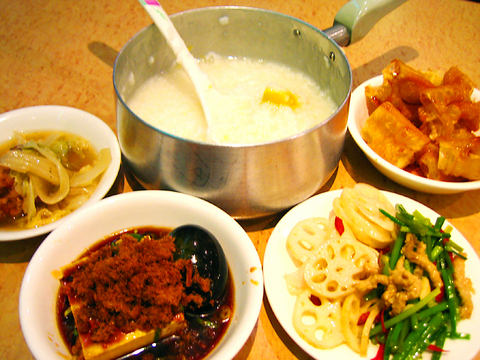Congee is a bland food. That's why it's a breakfast food in countries from Vietnam to Japan. But at the congee restaurants on Fuxing Road between Da'an and Technology Building MRT stations, it's a midnight snack.
Xiao Lizi is one of those restaurants with floor-to-ceiling windows revealing an ample buffet. A hostess stands outside telling passersby to stop for a snack. The place is less flashy but more popular than the others on either side and both floors fill up by 8pm, with customers streaming in and out into the wee hours of the morning. With a clean and simple decor, it's the perfect place to take a breather from your night on the town.
Congee can suffer from bad texture, which just compounds the problem of its blandness. But the congee you'll find at Xiao Lizi is a far cry from the leftover rice soaking in milky water that visits many a breakfast table in Taiwan. The ingredients are simple enough -- rice and water -- but a good consistency is difficult to attain with congee. If you cook it for too long, the rice grains disintegrate -- too short and the broth will be too watery. After cooking, the excess water can be drained to create a Western porridge-like consistency or left in to make it more like a soup. Xiao Lizi's congee is somewhere in between. Chunks of yam are thrown in to sweeten and thicken the mixture and the result is a pot of smooth, glowing goo.

PHOTO: MEREDITH DODGE, TAIPEI TIMES
The buffet table is the other option at Xiao Lizi. The first thing you must remember to put on your tray is a bowl of youtiao -- a stick of fried bread cut into sections to be soaked in the congee until it's tender and squishy.
Another typical congee side dish is thousand-year egg. One of the substances used to preserve the eggs (is it the charcoal or the lime?) reacts strangely with sweet flavors and if you take a bite of congee after a bite of the thousand-year egg without thoroughly rinsing your mouth, you will be greeted with a most unpleasant bitterness.
I found that, in general, the sweeter dishes went best with the congee, especially the deliciously crunchy lotus root and the tender leeks. If your stomach is up for it at that time of night, there are many other tempting dishes to try: stinky tofu, kung pao chicken, and several hearty stews. A selection of greens can be stir-fried or boiled to order.
If the thought of eating salty, fried dishes with sweet porridge turns you off, just ask for a pot of steamed rice instead.

The Taipei Times last week reported that the rising share of seniors in the population is reshaping the nation’s housing markets. According to data from the Ministry of the Interior, about 850,000 residences were occupied by elderly people in the first quarter, including 655,000 that housed only one resident. H&B Realty chief researcher Jessica Hsu (徐佳馨), quoted in the article, said that there is rising demand for elderly-friendly housing, including units with elevators, barrier-free layouts and proximity to healthcare services. Hsu and others cited in the article highlighted the changing family residential dynamics, as children no longer live with parents,

It is jarring how differently Taiwan’s politics is portrayed in the international press compared to the local Chinese-language press. Viewed from abroad, Taiwan is seen as a geopolitical hotspot, or “The Most Dangerous Place on Earth,” as the Economist once blazoned across their cover. Meanwhile, tasked with facing down those existential threats, Taiwan’s leaders are dying their hair pink. These include former president Tsai Ing-wen (蔡英文), Vice President Hsiao Bi-khim (蕭美琴) and Kaohsiung Mayor Chen Chi-mai (陳其邁), among others. They are demonstrating what big fans they are of South Korean K-pop sensations Blackpink ahead of their concerts this weekend in Kaohsiung.

Taiwan is one of the world’s greatest per-capita consumers of seafood. Whereas the average human is thought to eat around 20kg of seafood per year, each Taiwanese gets through 27kg to 35kg of ocean delicacies annually, depending on which source you find most credible. Given the ubiquity of dishes like oyster omelet (蚵仔煎) and milkfish soup (虱目魚湯), the higher estimate may well be correct. By global standards, let alone local consumption patterns, I’m not much of a seafood fan. It’s not just a matter of taste, although that’s part of it. What I’ve read about the environmental impact of the

Oct 20 to Oct 26 After a day of fighting, the Japanese Army’s Second Division was resting when a curious delegation of two Scotsmen and 19 Taiwanese approached their camp. It was Oct. 20, 1895, and the troops had reached Taiye Village (太爺庄) in today’s Hunei District (湖內), Kaohsiung, just 10km away from their final target of Tainan. Led by Presbyterian missionaries Thomas Barclay and Duncan Ferguson, the group informed the Japanese that resistance leader Liu Yung-fu (劉永福) had fled to China the previous night, leaving his Black Flag Army fighters behind and the city in chaos. On behalf of the